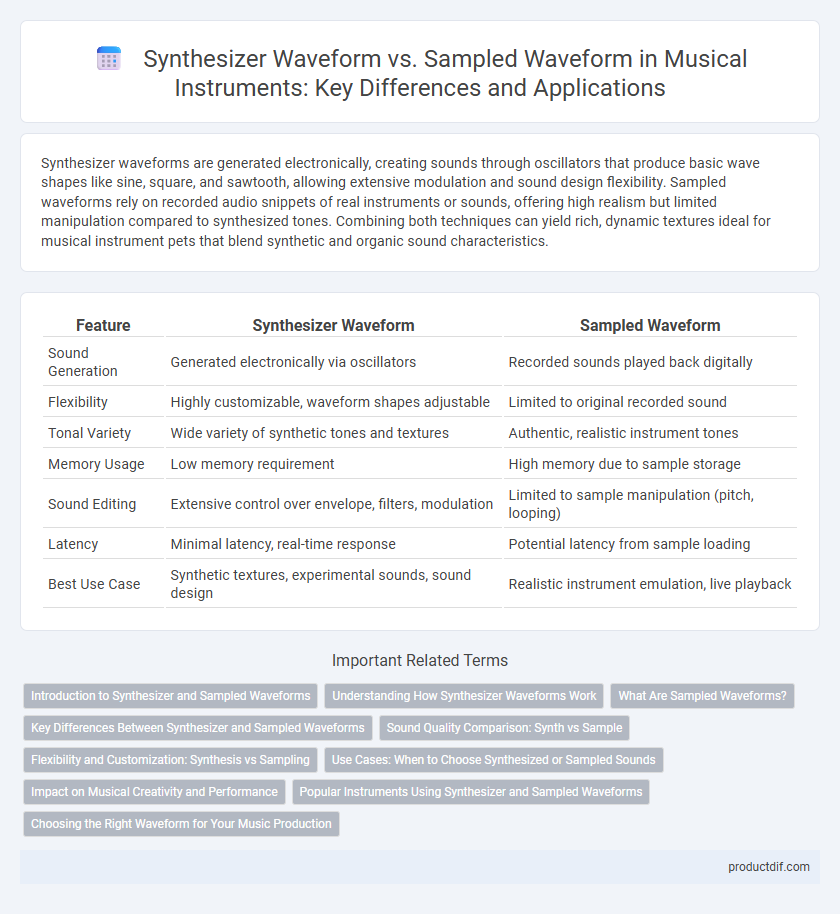Synthesizer waveforms are generated electronically, creating sounds through oscillators that produce basic wave shapes like sine, square, and sawtooth, allowing extensive modulation and sound design flexibility. Sampled waveforms rely on recorded audio snippets of real instruments or sounds, offering high realism but limited manipulation compared to synthesized tones. Combining both techniques can yield rich, dynamic textures ideal for musical instrument pets that blend synthetic and organic sound characteristics.
Table of Comparison
| Feature | Synthesizer Waveform | Sampled Waveform |
|---|---|---|
| Sound Generation | Generated electronically via oscillators | Recorded sounds played back digitally |
| Flexibility | Highly customizable, waveform shapes adjustable | Limited to original recorded sound |
| Tonal Variety | Wide variety of synthetic tones and textures | Authentic, realistic instrument tones |
| Memory Usage | Low memory requirement | High memory due to sample storage |
| Sound Editing | Extensive control over envelope, filters, modulation | Limited to sample manipulation (pitch, looping) |
| Latency | Minimal latency, real-time response | Potential latency from sample loading |
| Best Use Case | Synthetic textures, experimental sounds, sound design | Realistic instrument emulation, live playback |
Introduction to Synthesizer and Sampled Waveforms
Synthesizers generate sounds by creating and manipulating waveforms such as sine, square, and sawtooth, allowing precise control over tone and timbre through oscillators and filters. Sampled waveforms use digital recordings of real instruments or sounds, providing authentic audio textures by playing back these captured samples with modifications in pitch and duration. The combination of synthesized waveforms and sampled waveforms expands the sonic palette available to musicians, enabling both synthetic sound generation and realistic instrument emulation.
Understanding How Synthesizer Waveforms Work
Synthesizer waveforms generate sound by manipulating electrical signals to create oscillating patterns like sine, square, sawtooth, and triangle waves, each producing distinct timbres essential in sound synthesis. Sampled waveforms capture and playback real instrument sounds or audio snippets, relying on digital recordings rather than signal generation, which limits timbral flexibility but offers realistic textures. Understanding these differences highlights that synthesizer waveforms provide greater control over tonal design through parameter modulation, while sampled waveforms excel in authentic replication of acoustic instruments.
What Are Sampled Waveforms?
Sampled waveforms are digital recordings of real instruments or sounds captured and stored as audio files, allowing synthesizers to reproduce authentic timbres with high fidelity. Unlike synthetic oscillators generating basic wave shapes like sine or square waves, sampled waveforms offer rich, complex harmonic content derived from actual performances. This technology enhances realism in electronic music production by providing natural tone variations, articulations, and dynamic nuances found in acoustic instruments.
Key Differences Between Synthesizer and Sampled Waveforms
Synthesizer waveforms are generated using oscillators that create continuous electronic signals such as sine, square, sawtooth, and triangle waves, allowing for extensive sound shaping and modulation. Sampled waveforms, on the other hand, rely on recorded audio clips of real instruments or sounds, providing authentic timbres but with less flexibility for dynamic alteration. Key differences include the level of control over harmonic content and evolution of sound, with synthesizers offering infinite manipulation while sampled waveforms maintain realistic acoustic characteristics.
Sound Quality Comparison: Synth vs Sample
Synthesizer waveforms generate sound through electronic oscillators, offering infinite modulation possibilities and dynamic expressiveness, ideal for creating unique, evolving tones. Sampled waveforms capture real instrument recordings, delivering authentic timbres and rich nuances that maintain natural acoustic qualities. While synthesizers excel in sound design versatility, sampled waveforms provide superior realism and consistent sound quality for traditional instrument emulations.
Flexibility and Customization: Synthesis vs Sampling
Synthesizer waveforms offer extensive flexibility through real-time modulation, allowing users to shape sounds by adjusting parameters like oscillators, filters, and envelopes. Sampled waveforms provide accurate, high-fidelity reproductions of recorded sounds but are limited in customization beyond pitch and basic effects. Synthesis enables dynamic sound design from raw waveforms, while sampling relies on existing recordings, impacting the degree of creative control and sonic variation.
Use Cases: When to Choose Synthesized or Sampled Sounds
Synthesizer waveforms excel in creating evolving, dynamic sounds ideal for electronic music, sound design, and experimental genres due to their flexibility in modulation and real-time parameter control. Sampled waveforms suit realistic instrument emulation and genres requiring authentic acoustic textures, making them essential for orchestral compositions, film scoring, and realistic playback. Choosing synthesized sounds benefits artists seeking unique textures and custom timbres, while sampled sounds are preferred for accurate reproduction of existing instruments and natural sonic detail.
Impact on Musical Creativity and Performance
Synthesizer waveforms offer dynamic sound design capabilities through real-time modulation and manipulation, enabling musicians to create unique timbres and evolving textures. Sampled waveforms provide authentic replication of acoustic instruments, allowing performers to integrate realistic sounds with precise articulation and nuanced expression. The choice between synthesized and sampled waveforms significantly impacts musical creativity and performance by balancing between innovative sound creation and faithful reproduction.
Popular Instruments Using Synthesizer and Sampled Waveforms
Popular instruments leveraging synthesizer waveforms include the Moog Sub 37 and Korg Minilogue, known for their rich analog oscillators and real-time modulation capabilities. In contrast, sampled waveform instruments like the Akai MPC series and Native Instruments Kontakt excel at delivering precise, high-quality emulations of acoustic sounds through extensive sample libraries. Both approaches dominate modern music production, with synthesizer waveforms favored for sound design flexibility and sampled waveforms prized for authentic instrument replication.
Choosing the Right Waveform for Your Music Production
Selecting the appropriate waveform in music production depends on the desired sound texture and flexibility. Synthesizer waveforms offer dynamic control and modulation possibilities, ideal for creating unique tones and evolving sounds, while sampled waveforms provide realistic, pre-recorded timbres perfect for authenticity and replication of acoustic instruments. Balancing the synthetic manipulation of oscillator-generated waves with the natural complexity of sampled audio enables producers to tailor their soundscapes effectively across genres.
Synthesizer waveform vs sampled waveform Infographic

 productdif.com
productdif.com